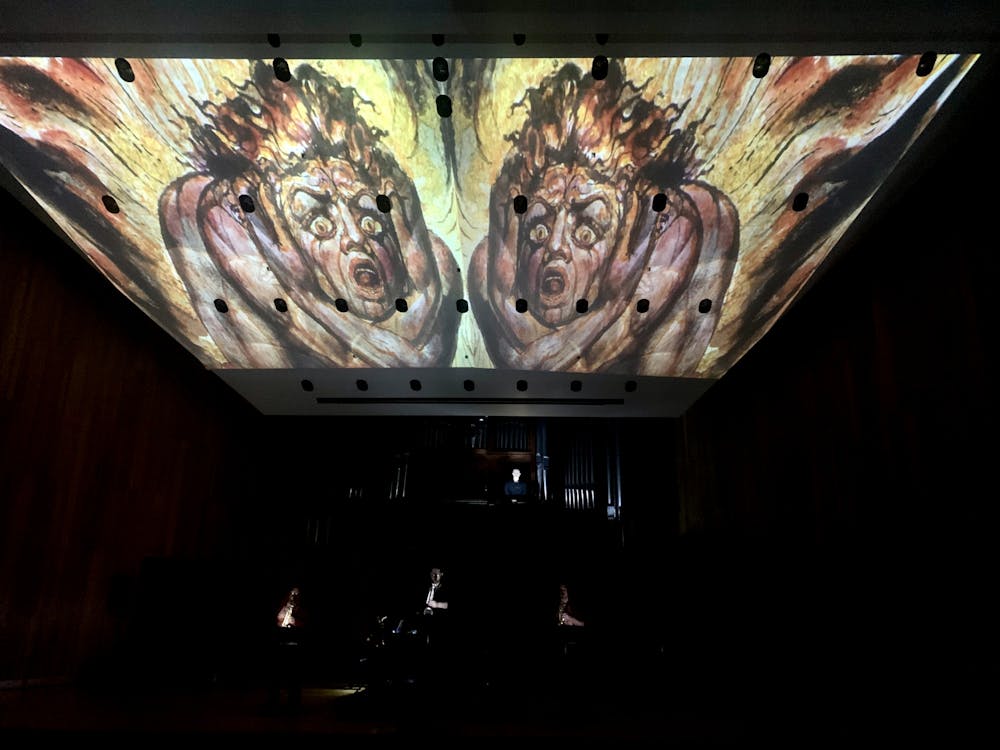Their music is intentionally uncomfortable. The saxophonists huff and puff into their instruments, producing a harsh sound rather than a resonant one. The occasional melody doesn’t last long before it’s interrupted by wails and moans. It’s a perpetual cycle of grating sounds and interrupted harmonies.
But that’s just how Tiffany Skidmore and Kyle Hutchins make music.
“The William Blake Cycle: Unseen, Unbodied, Unknown” electrified Lippes Concert Hall this past Friday, Sept. 8. The show, a culmination of a decade’s worth of collaboration, expands the boundaries of instrumental music.
Since 2015, composer Tiffany Skidmore and saxophone soloist Kyle Hutchins have performed experimental music that explores William Blake’s mythological characters. They’ve combined the saxophone, imagery and other audio to create movements rich with messages.
In their universe, supernatural feminine and masculine personas aim to dominate the other — femininity and masculinity cannot coexist. As a result, many characters, fueled by internalized patriarchal ideals, hide their feminine identity, with little to no success. Throughout the show, their gender dysphoria torments them as they remain continuously trapped in a conflicted cycle of their own making. The feminine voice desperately tries to break through but is often stifled.
It takes great mental stamina and endurance. The musicians must actively move to cue in their colleagues at the right time. After so many performances, they’ve almost perfected the rhythm.
Yet, each performance is different.
“The pieces — like the costumes, videos, music — are the same. But the movement and the way that we think about ourselves in the space has totally changed,” Hutchins said. “You can imagine that with any venue that we do in the future, [the music] has to be different. We have to adapt.”
For example, their original space — a four-story block with audience members flanking either side of the stage — was nothing like Lippes Concert Hall. Only the main saxophonist moved around the stage, while the other band members remained stationary.
In contrast, in Lippes Concert Hall, the main saxophonist, dressed in black, was the only one who remained on stage at all times. The other musicians, cloaked in red musculoskeletal costumes, were scattered around the auditorium, moving around and rubbing their hands together.
“Everyone else is like my appendage,” Hutchins said.

Photo provided by Tiffany Skidmore
It’s a testament to how the show has changed during its run. The performers have had to build trust with each other in order to maintain the original spirit of the show while continuing to innovate.
“We’ve worked together for a while, and I trust them implicitly. They’re amazing musicians,” Skidmore said.
Skidmore has had to deliberately cultivate that trust. Throughout the composing process, she’s sought to keep performers comfortable, even sometimes changing certain aspects of the piece itself to achieve that.
“Throughout the piece, we’ve tried things and experimented with different ideas,” Skidmore said. “For example, the pianist had moments where she was running her fingernails across the keyboard. However, she doesn’t have fingernails because she’s a pianist. And I didn’t think about that because I don’t cut my fingernails. So we had to adapt that to make the sound audible.”
Now, even though the piece is finalized and structured, musicians still find creative freedom and growth within the notes.
Sheldon Johnson, a saxophonist, described the whole process as “dynamic.”
“Our performance grows like an organism,” Johnson said. “Every time I come back to it, I notice something new and different. This time, I felt a little bit more free to interact purposefully with the sound I was hearing from the track and my colleagues. It felt more organic.”
Much of this piece is unconventional, from the constant tinkering and reimaginings all the way down to the minor details. In fact, the programs were actually handed out at the end of the show instead of the beginning.
“It’s for practical reasons: it minimizes the noise of having a paper program since everyone’s jostling, taking their phone out, reading the program, etc.,” Annie Stevens, a percussionist who played both the vibraphone and the cowbell, explained. “But it’s also to be able to think and take it all in without necessarily having an outline.”
The arts desk can be reached at arts@ubspectrum.com

Mylien Lai is the senior news editor at The Spectrum. Outside of getting lost in Buffalo, she enjoys practicing the piano and being a bean plant mom. She can be found at @my_my_my_myliennnn on Instagram.





